Creating Statistics for China’s Building Energy Consumption Using an Adapted Energy Balance Sheet
Abstract
:1. Introduction
- Sampling surveys [8]. Surveys are widely applied to get detailed information on building energy demand. However, it is costly and impossible for surveys to cover all buildings. Therefore sampling surveys are applied. The scale of the survey depends on the resources and complete data of building energy demand at the sector level is calculated, based on the survey results and estimated total floor areas of all types of buildings.
- Statistics for defined-scale and defined-type buildings [9,10,11,12]. This method builds on building energy consumption statistics that are applied for defined-scale buildings (e.g., with a floor area of more than 10.000 m2) and defined-type buildings (public buildings), and statistics gathered by local statistics departments. Total building energy consumption can therefore be estimated by using the statistical data.
- Modelling [6,13,14,15]. Modelling is widely used by academic institutes for estimating energy consumption at the sector level. Models are developed based on building types and building stocks, building age, characters of climate zones, and total floor areas of each type of buildings in each of China’s climate zones.
- EBS together with expert approach [16,17,18]. In the EBS of IEA and other developed countries, energy consumption data is collected for the three main sectors of industrial, transportation and buildings, and thus data of building energy consumption is available from the EBS database. However, building energy consumption data in China’s EBS is divided into the different sectors of industries, transportation, consumptions and others. Thus getting building energy consumption data from China’s EBS needs additional work that may be done by professional energy analysts and therefore the EBS together with expert approach is applied to gather building energy consumption data.
- Developing and testing a method that is adapted from China’s existing EBS. This method is applied to calculate China building energy consumption at the sector level.
- Comparing the calculated results of this research with other sources and evaluating what the differences are between this research and other similar researches.
- Comparing the energy consumption of China’s commercial (so-called public buildings in China), urban residential and rural residential buildings by the calculated results of this research for the period of 2001–2015.
- Analyzing building energy demand against economic growth to gain insights on differences of energy demand in industrial and building sectors.
- Comparing China’s building energy demand with international practices, in particular with the USA, European Union and Japan.
- Recommending how China could build up its building energy consumption statistical system by applying the adapted EBS.
2. Methods
2.1. Procedures and Methods of This Research
2.2. Data Collection and Analysis
3. Results
3.1. China Building Energy Consumption 2001–2015
3.2. Energy Consumption of Building Types in China
3.3. China Building Energy Consumption Against Economic Growth
3.4. China Building Energy Consumption: an International Comparison
4. Discussion
5. Conclusions
- The building energy statistics by adapted EBS covers all types of buildings (commercial and residential buildings and multi-functions buildings that are used by sectors of industry, transportation and others), and it provides reliable, detailed and complete data on energy demand in China’s building sector. Based on EBS data, this method can be included in regular energy statistical system and can be standardized in a transparent way. Thus data generated by this method will ensure the international, national and regional comparisons and benchmarking of building energy demand.
- Data comparison between this research and the existing most adopted China Building Energy Model (CBEM) shows no significant differences. We therefore suggest that both methods can be used for cross-checking to build up China statistics of building energy consumption.
- Both total energy consumption and building energy consumption have increased by about 7.6% in China since 2001. However the growth rate of total energy consumption is slowing down and annual growth of building energy consumption has been stabilized, although total building floor area is increasing by about 4%. Decoupling of building energy consumption with increasing of building floor area is due to the improvement of building energy efficiency.
- The energy consumption of public buildings accounts for a 37%–41% share of the total building energy consumption, residential buildings represent 36%–39% and rural residential buildings have a 23%–25% share in China. The energy intensity of commercial buildings is the highest compared to urban and rural residential buildings and the energy intensity of urban residential buildings is almost double that of rural residential buildings in China. This is completely different from the situation in Europe, where the energy efficiency of rural households is always higher than in urban households [23]. This research concludes that there are tremendous differences in the building energy efficiency of rural buildings between China and Europe, since building energy efficiency solutions are less developed in rural China [24,25,26,27].
- Building energy consumption and industrial energy consumption features are different. Building energy consumption is driven by lifestyle and living standards. However, industrial energy consumption is mainly driven by market and economic activities. Therefore, a higher GDP growth results in an increased share of industrial energy consumption and a decreased share of building energy consumption.
- China’s building energy consumption has less of a contribution to the total energy demand, as compared to that of the developed world. This shows that China industrialization is still playing a more important role in the energy demand, while consumption and transportation sectors have more of a contribution to the total energy demand in the developed world.
Author Contributions
Funding
Acknowledgments
Conflicts of Interest
References
- IEA (International Energy Agency). World Energy Balances: Complete Energy Balances for over 150 Countries and Regions. 2018. Available online: https://www.iea.org/statistics/balances/ (accessed on 9 November 2019).
- Fridley, D.; Zheng, N.; Zhou, N. Estimating Total Energy Consumption and Emissions of China’s Commercial and Office Buildings (LBCN-248E Report); Lawrence Berkley National Laboratory: Berkeley, CA, USA, 2008. [Google Scholar]
- Asimakopoulos, D.A.; Santamouris, M.; Farrou, I.; Laskari, M.; Saliari, M.; Zanis, G.; Giannakidis, G.; Tigas, K.; Kapsomenakis, J.; Douvis, C.; et al. Modelling the energy demand projection of the building sector in Greece in the 21st century. Energy Build 2012, 49, 488–498. [Google Scholar] [CrossRef]
- Zhang, M.; Wang, M.; Jin, W.; Xia-Bauerc, C. Managing energy efficiency of buildings in China: A survey of energy performance contracting (EPC) in building sector. Energy Policy 2018, 114, 13–21. [Google Scholar] [CrossRef]
- Gu, L.; Yu, C. Data status and statistics of China building energy consumption. China Energy 2011, 33, 38–41. [Google Scholar]
- Building Energy Research Centre of Tsinghua University (THUBERC). 2017 Annual Report on China Building Energy Efficiency; China Architecture & Building Press: Beijing, China, 2017; pp. 7–9. ISBN 978-7-112-20573-8. [Google Scholar]
- Wang, Q. 2007 Research on statistics and calculation of China building energy consumption. Energy Sav. Environ. Prot. 2007, 8, 9–10. [Google Scholar]
- Long, H. Percentage of building energy consumption and building energy efficiency targets. China Energy 2005, 10, 23–27. [Google Scholar]
- Ding, J. Discussions on statistics and methodology of China building energy consumption. Mod. Econ. Inf. 2011, 23, 191. [Google Scholar]
- Chen, S.; Li, N.; Guan, J. Research on statistical methodology to investigate energy consumption in public buildings sector in China. Energy Convers. Manag. 2008, 49, 2152–2159. [Google Scholar] [CrossRef]
- Lombard, P.; Ortiz, J.; Pout, C. A review on buildings energy consumption information. Energy Build. 2008, 40, 394–398. [Google Scholar] [CrossRef]
- Zhao, L.; Liang, R.; Zhang, J.; Ma, L.; Zhao, T. A new method for building energy consumption statistics evaluation: Ratio of real energy consumption expense to energy consumption. Energy Syst. 2014, 5, 627–642. [Google Scholar] [CrossRef]
- Zhou, N.; Lin, J. The reality and future scenarios of commercial building energy consumption in China. Energy Build. 2008, 40, 2121–2127. [Google Scholar] [CrossRef]
- Zhang, Y.; He, C.; Tang, B.; Wei, Y. China’s energy consumption in the building sector: A life cycle approach. Energy Build. 2015, 94, 240–251. [Google Scholar] [CrossRef]
- Jiang, Y. Chinese building energy consumption situation and energy efficiency strategy. New Archit. 2008, 2, 4–8. [Google Scholar]
- Chen, S.; Li, N.; Guan, J.; Xie, Y.; Sun, F.; Ni, J. A statistical method to investigate national energy consumption in the residential building sector of China. Energy Build. 2008, 40, 654–665. [Google Scholar] [CrossRef]
- Xiao, H.; Wei, Q.; Jiang, Y. The reality and statistical distribution of energy consumption in office buildings in China. Energy Build. 2012, 50, 259–265. [Google Scholar] [CrossRef]
- Lin, X.; Peng, J.; Jiang, H. Study on statistics and calculation of building energy consumption in Chongqing City. Build. Energy Effic. 2008, 36, 55–57. [Google Scholar]
- China Association of Building Energy Efficiency (CABEE). 2017 Research Report of China Building Energy Consumption; China Association of Building Energy Efficiency: Beijing, China, 2017; pp. 1–25. [Google Scholar]
- Yu, S.; Eom, J.; Evans, M.; Clarke, L. A long-term, integrated impact assessment of alternative building energy code scenarios in China. Energy Policy 2014, 67, 626–639. [Google Scholar] [CrossRef]
- Liu, X.; Wang, C.; Liang, C.; Feng, G.; Yin, Z.; Li, Z. Effect of the energy-saving retrofit on the existing residential buildings in the typical city in northern China. Energy Build. 2018, 177, 154–172. [Google Scholar]
- Wang, J.; Zhang, Y.; Liu, M.; Wang, Y. Baseline comparison of China, USA and UK building energy consumption. Build. Sci. 2015, 31, 48–51. [Google Scholar] [CrossRef]
- Heinonen, J.; Junnila, S. Residential energy consumption patterns and the overall housing energy requirements of urban and rural households in Finland. Energy Build. 2014, 76, 295–303. [Google Scholar] [CrossRef]
- Yang, X. Introduction on building energy consumption statistics of USA. Build. Sci. 2010, 26, 8–11. [Google Scholar] [CrossRef]
- Zhang, M.; Cui, Y.; ter Avest, E.; van Dijk, M.P. Adoption of voluntary approach: Can voluntary approach generate collective impacts for China achieving ambitious energy efficiency targets? Energy Environ. 2018, 29, 281–299. [Google Scholar] [CrossRef]
- Zhang, M.; Li, H.; Jin, W.; ter Avest, E.; van Dijk, M.P. Voluntary agreements to achieve energy efficiency, a comparison between China and The Netherlands. Energy Environ. 2018, 29, 989–1003. [Google Scholar] [CrossRef]
- Lu, N.; Lin, G.; Yu, Y.; Ma, H.; Wang, Q. Analysis on China’s residential building energy consumption in 2003–2007. Constr. Econ. 2009, 95–97. [Google Scholar] [CrossRef]
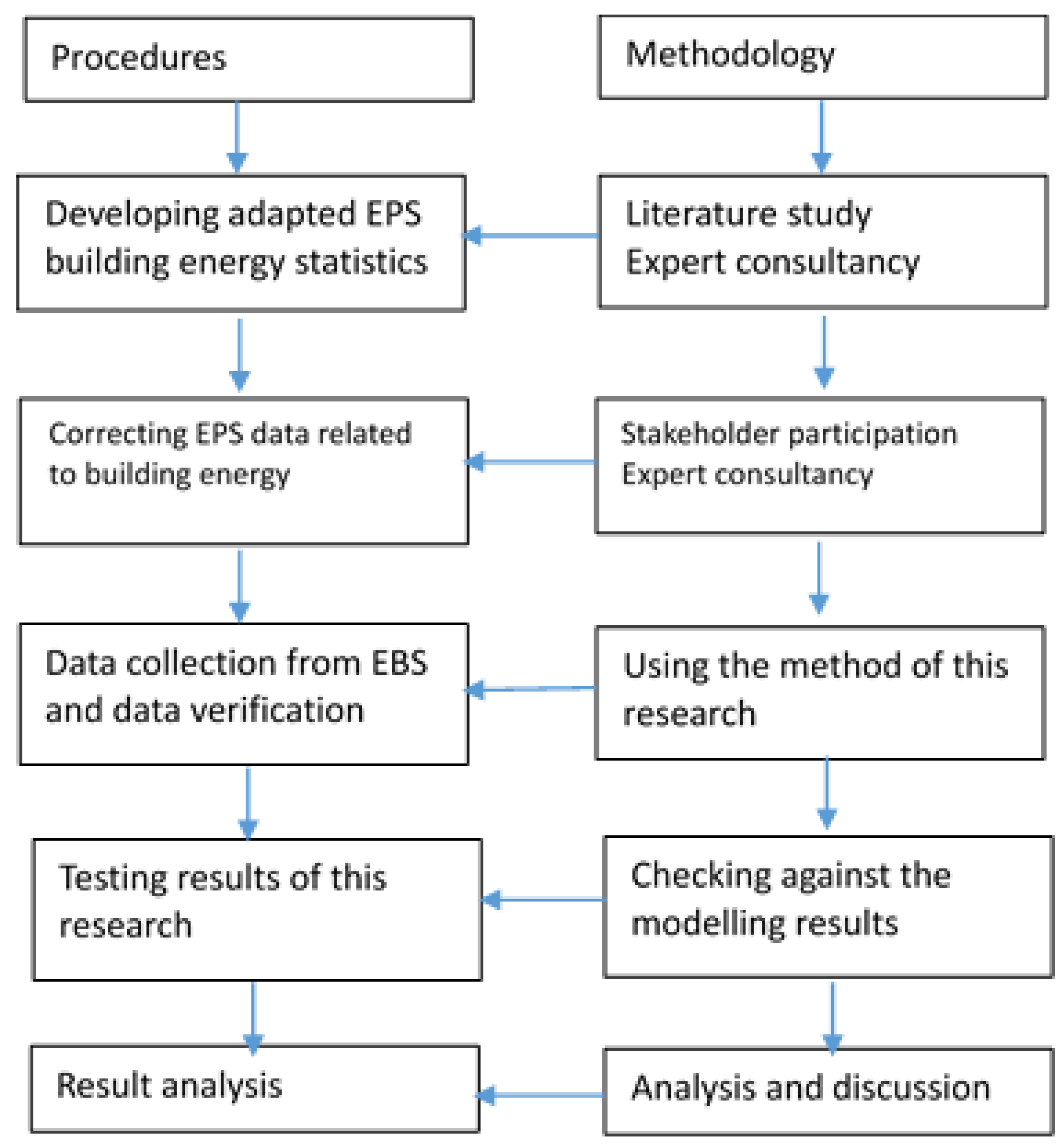
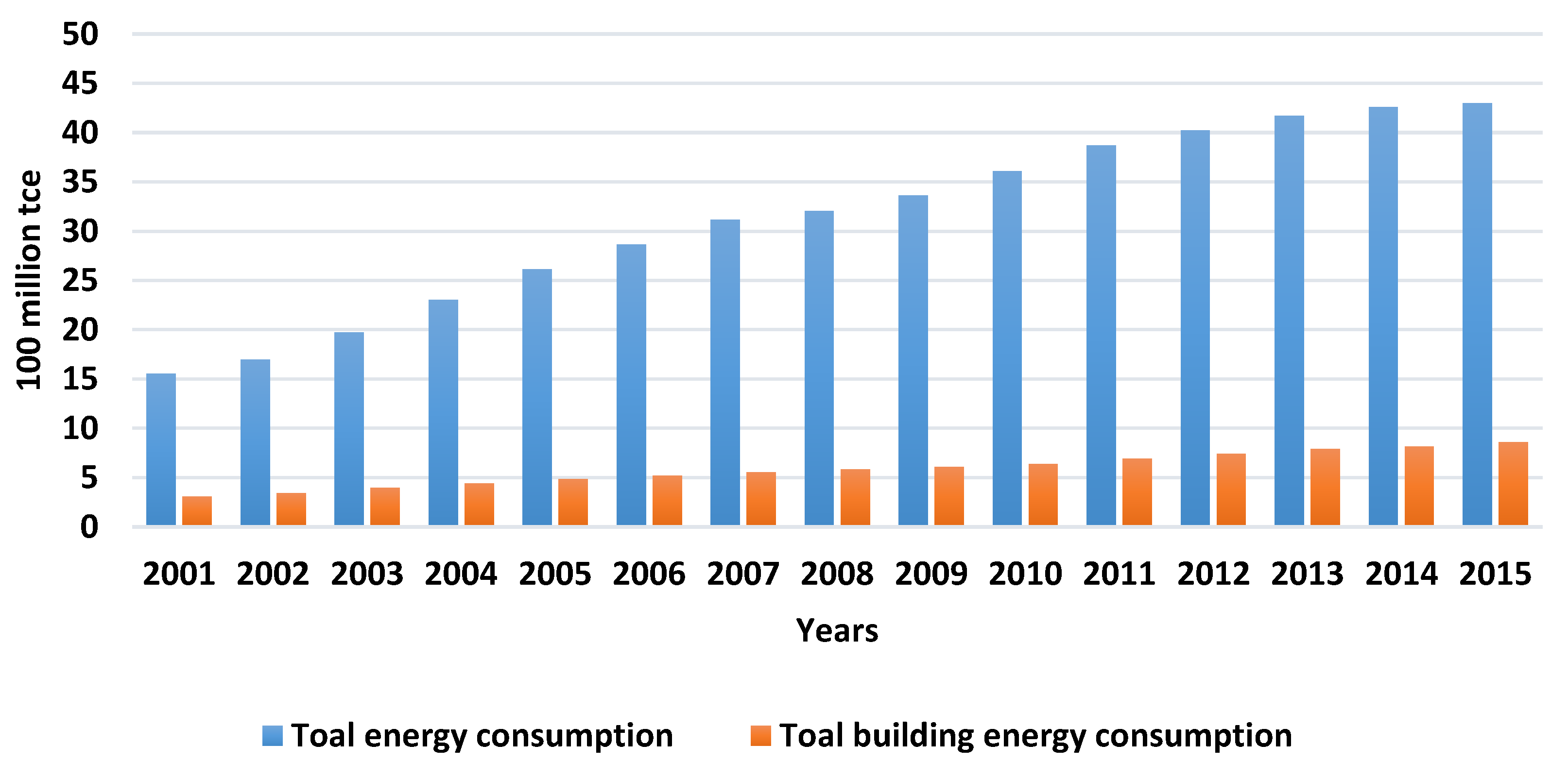
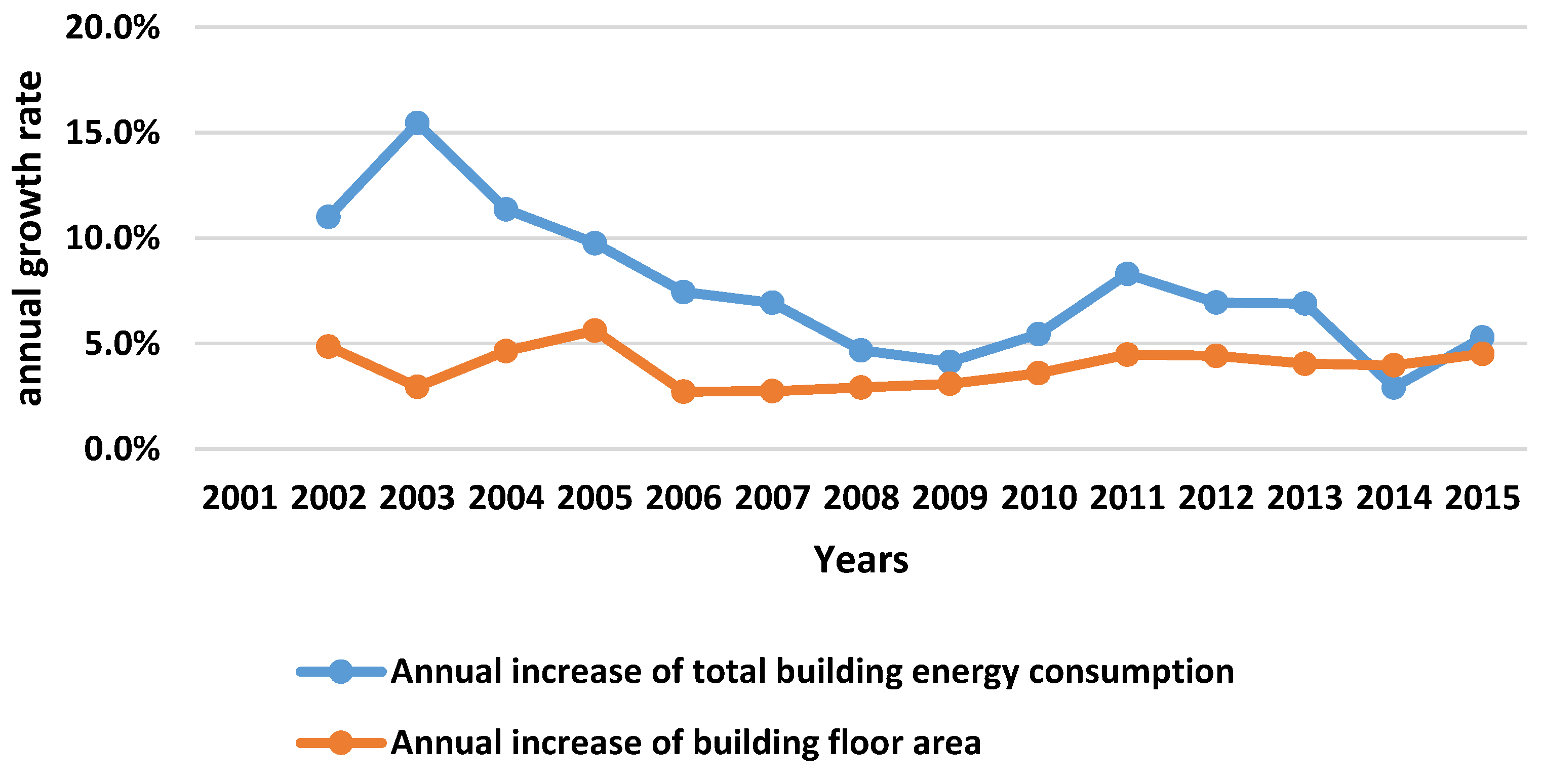
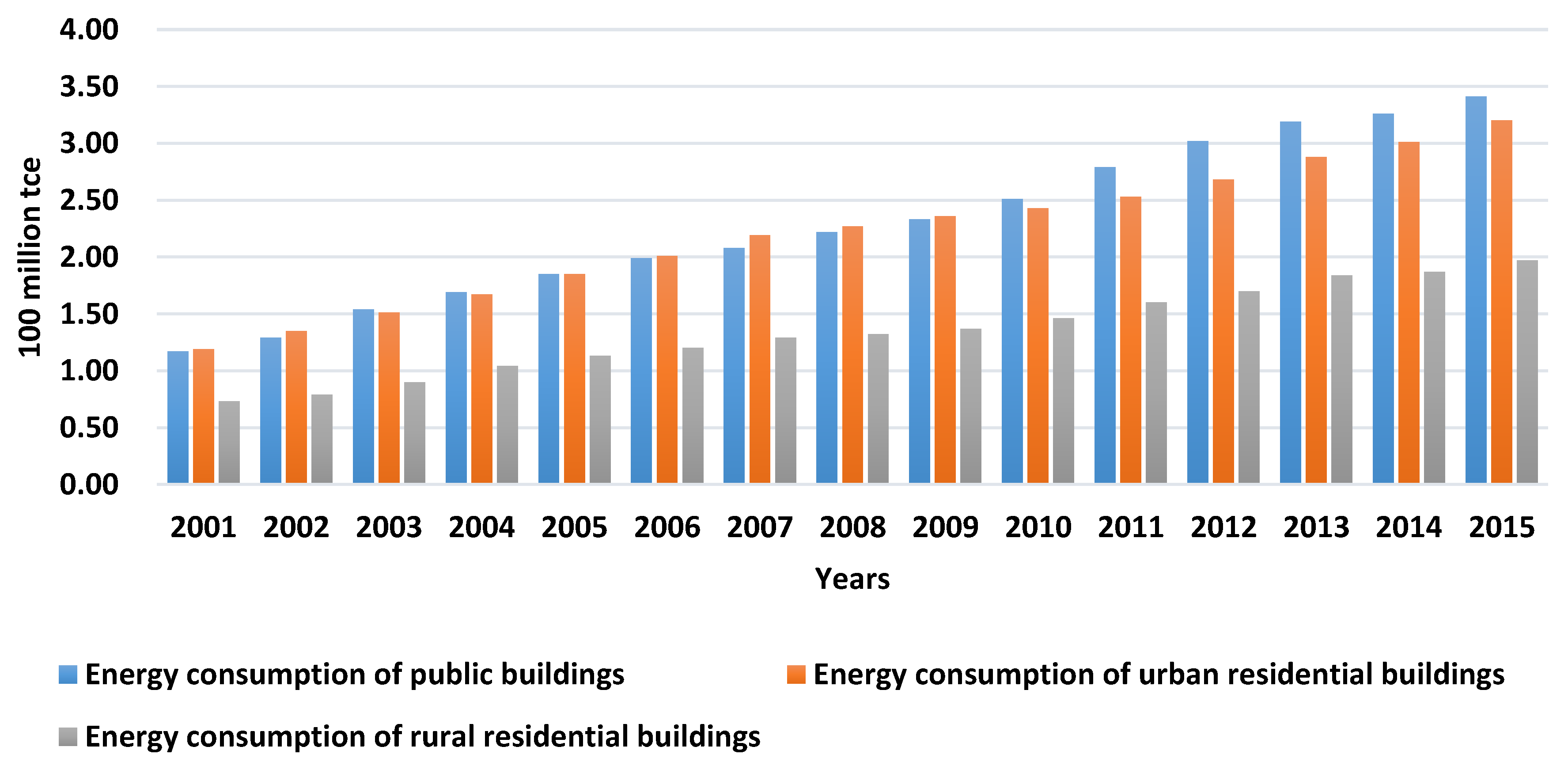
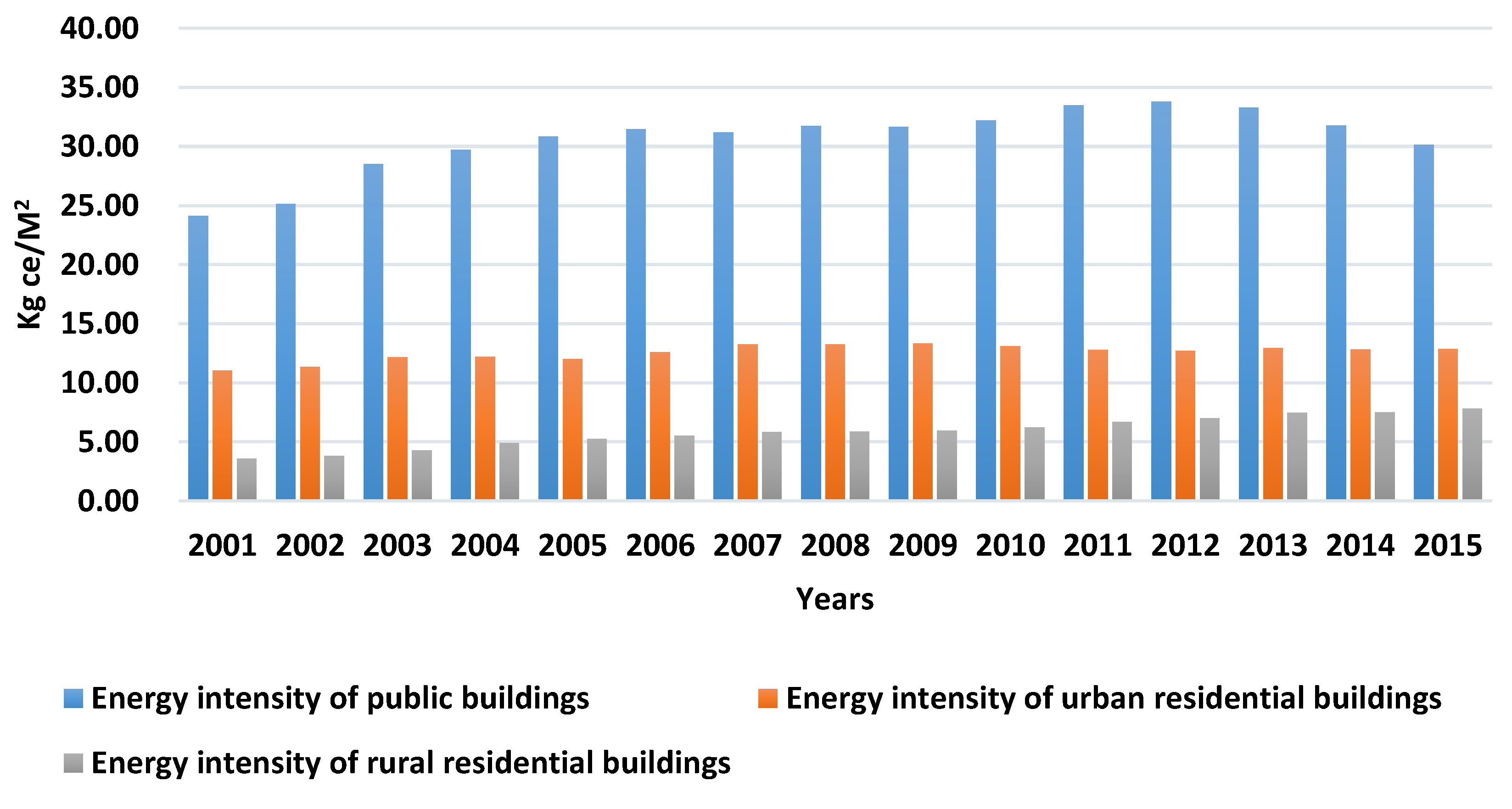
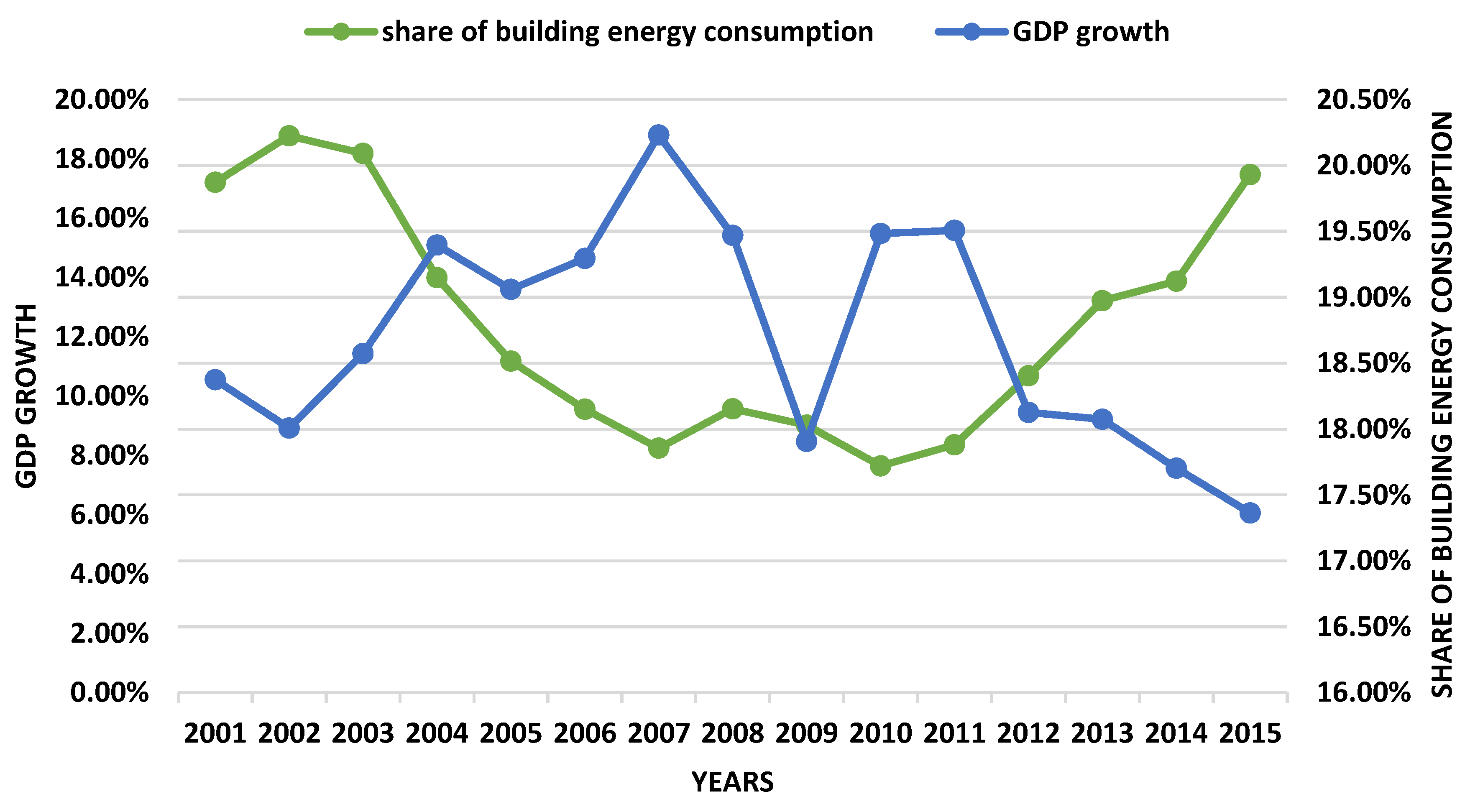
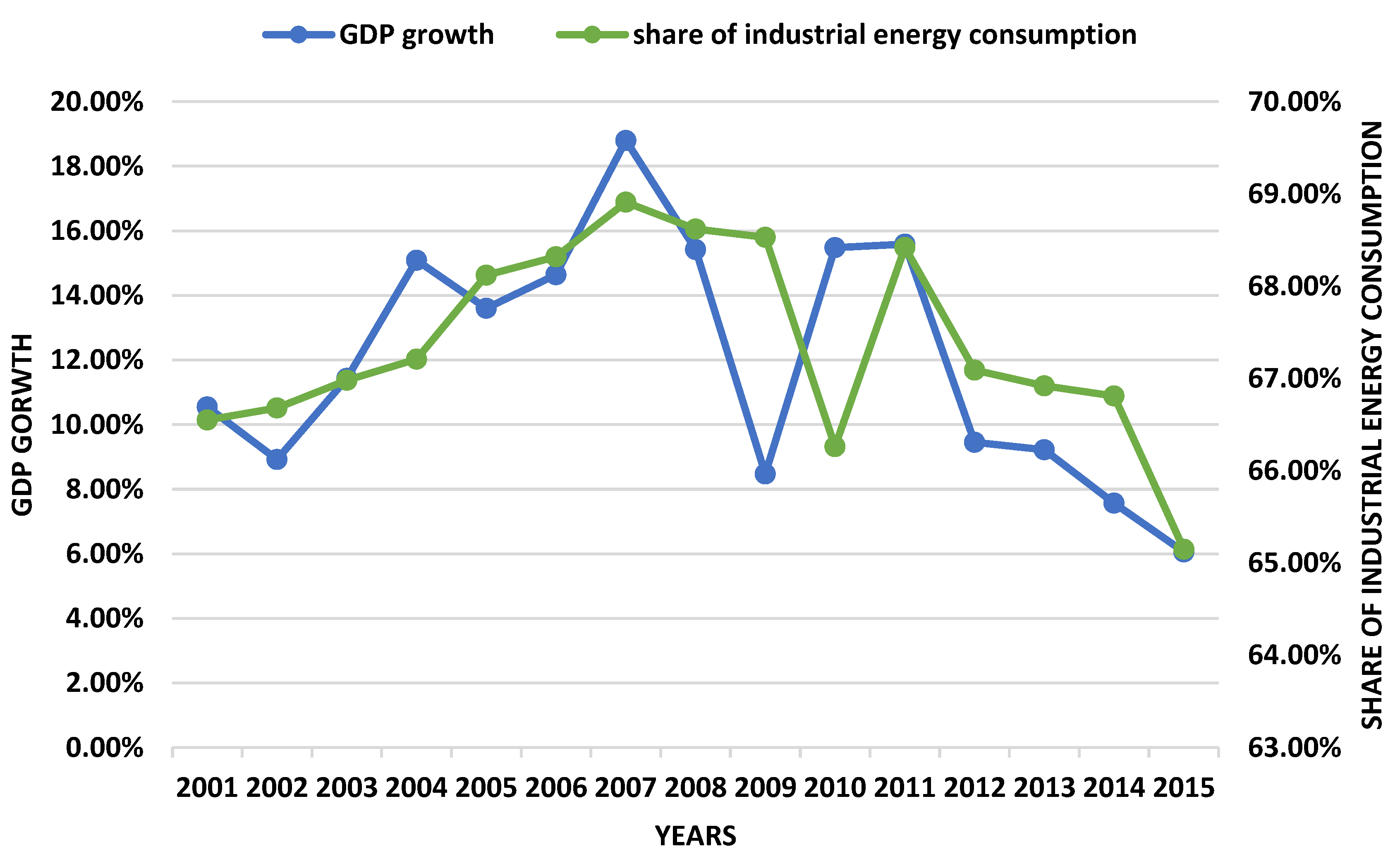
| Indicator | 2001–2005 | 2006–2010 | 2011–2015 |
|---|---|---|---|
| Average annual growth of China total energy consumption | 13.9% | 5.9% | 2.7% |
| Average annual growth of China total building energy consumption | 11.9% | 5.3% | 5.5% |
| Year | This Research | CBEM [6] | Difference |
|---|---|---|---|
| 2001 | 3.09 | 3.7 | 19.7% |
| 2002 | 3.43 | 4.1 | 19.5% |
| 2003 | 3.96 | 4.5 | 13.6% |
| 2004 | 4.41 | 5.20 | 17.9% |
| 2005 | 4.84 | 5.50 | 13.6% |
| 2006 | 5.20 | 5.63 | 8.3% |
| 2007 | 5.56 | 5.76 | 3.6% |
| 2008 | 5.82 | 5.93 | 1.9% |
| 2009 | 6.06 | 6.22 | 2.6% |
| 2010 | 6.39 | 6.65 | 4.1% |
| 2011 | 6.92 | 6.95 | 0.4% |
| 2012 | 7.40 | 7.22 | -2.4% |
| 2013 | 7.91 | 7.81 | -1.3% |
| 2014 | 8.14 | 8.22 | 1.0% |
| 2015 | 8.57 | 8.64 | 0.8% |
| Building Types | This Study | CBEM | Difference |
|---|---|---|---|
| Public building | 2.83 | 2.60 | –8.8% |
| Urban residential building | 1.85 | 1.99 | 7.0% |
| Rural residential building | 1.97 | 2.13 | 7.5% |
| Northern China heating | 1.93 | 1.91 | –1% |
| Indicator | China | USA | EU | India | Russia | Japan | Global |
|---|---|---|---|---|---|---|---|
| Total energy consumption | 1913.0 | 1519.0 | 1042.5 | 577.6 | 456.9 | 291.3 | 6929 |
| Building energy consumption | 393.0 | 469.0 | 364.8 | 213.2 | 150.7 | 95.1 | 2807 |
| Share of building energy consumption | 20.5% | 30.9% | 35.0% | 36.9% | 33.0% | 32.6% | 40.5% |
© 2019 by the authors. Licensee MDPI, Basel, Switzerland. This article is an open access article distributed under the terms and conditions of the Creative Commons Attribution (CC BY) license (http://creativecommons.org/licenses/by/4.0/).
Share and Cite
Zhang, M.; Ge, X.; Zhao, Y.; Xia-Bauer, C. Creating Statistics for China’s Building Energy Consumption Using an Adapted Energy Balance Sheet. Energies 2019, 12, 4293. https://doi.org/10.3390/en12224293
Zhang M, Ge X, Zhao Y, Xia-Bauer C. Creating Statistics for China’s Building Energy Consumption Using an Adapted Energy Balance Sheet. Energies. 2019; 12(22):4293. https://doi.org/10.3390/en12224293
Chicago/Turabian StyleZhang, Mingshun, Xuan Ge, Ya Zhao, and Chun Xia-Bauer. 2019. "Creating Statistics for China’s Building Energy Consumption Using an Adapted Energy Balance Sheet" Energies 12, no. 22: 4293. https://doi.org/10.3390/en12224293
APA StyleZhang, M., Ge, X., Zhao, Y., & Xia-Bauer, C. (2019). Creating Statistics for China’s Building Energy Consumption Using an Adapted Energy Balance Sheet. Energies, 12(22), 4293. https://doi.org/10.3390/en12224293





